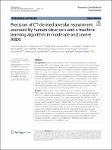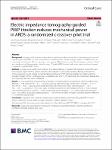Search
Author
- Andrew J., Weirauch (1)
- Aude, Verstraete (1)
- Elizabeth, Munroe (1)
- Jose Victor, Jimenez (1)
- next >
Subject
Date issued
- 2023 (2)
Has File(s)
- true (2)
Search Results
Assessing measurement error in alveolar recruitment on computed tomography (CT) is of paramount importance to select a reliable threshold identifying patients with high potential for alveolar recruitment and to rationalize positive end-expiratory pressure (PEEP) setting in acute respiratory distress syndrome (ARDS). The aim of this study was to assess both intra- and inter-observer smallest real difference (SRD) exceeding measurement error of recruitment using both human and machine learning-made lung segmentation (i.e., delineation) on CT. This single-center observational study was performed on adult ARDS patients. CT were acquired at end-expiration and end-inspiration at the PEEP level selected by clinicians, and at end-expiration at PEEP 5 and 15 cmH2O. |
In patients with acute respiratory distress syndrome undergoing mechanical ventilation, positive end-expiratory pressure (PEEP) can lead to recruitment or overdistension. Current strategies utilized for PEEP titration do not permit the distinction. Electric impedance tomography (EIT) detects and quantifies the presence of both collapse and overdistension. We investigated whether using EIT-guided PEEP titration leads to decreased mechanical power compared to high-PEEP/FiO2 tables. |


